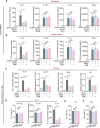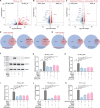Tonsillar Microbiome-Derived Lantibiotics Induce Structural Changes of IL-6 and IL-21 Receptors and Modulate Host Immunity
- PMID: 36031409
- PMCID: PMC9596850
- DOI: 10.1002/advs.202202706
Tonsillar Microbiome-Derived Lantibiotics Induce Structural Changes of IL-6 and IL-21 Receptors and Modulate Host Immunity
Abstract
Emerging evidence emphasizes the functional impacts of host microbiome on the etiopathogenesis of autoimmune diseases, including rheumatoid arthritis (RA). However, there are limited mechanistic insights into the contribution of microbial biomolecules especially microbial peptides toward modulating immune homeostasis. Here, by mining the metagenomics data of tonsillar microbiome, a deficiency of the encoding genes of lantibiotic peptides salivaricins in RA patients is identified, which shows strong correlation with circulating immune cells. Evidence is provided that the salivaricins exert immunomodulatory effects in inhibiting T follicular helper (Tfh) cell differentiation and interleukin-21 (IL-21) production. Mechanically, salivaricins directly bind to and induce conformational changes of IL-6 and IL-21 receptors, thereby inhibiting the bindings of IL-6 and IL-21 to their receptors and suppressing the downstream signaling pathway. Finally, salivaricin administration exerts both prophylactic and therapeutic effects against experimental arthritis in a murine model of RA. Together, these results provide a mechanism link of microbial peptides-mediated immunomodulation.
Keywords: IL-6 and IL-21 receptor; lantibiotics; rheumatoid arthritis; salivaricins; tonsillar microbiome.
© 2022 The Authors. Advanced Science published by Wiley-VCH GmbH.
Conflict of interest statement
The authors declare no conflict of interest.
Figures








Similar articles
-
Enhanced IL-6/phosphorylated STAT3 signaling is related to the imbalance of circulating T follicular helper/T follicular regulatory cells in patients with rheumatoid arthritis.Arthritis Res Ther. 2018 Aug 29;20(1):200. doi: 10.1186/s13075-018-1690-0. Arthritis Res Ther. 2018. PMID: 30157931 Free PMC article.
-
A regulatory effect of IL-21 on T follicular helper-like cell and B cell in rheumatoid arthritis.Arthritis Res Ther. 2012 Nov 23;14(6):R255. doi: 10.1186/ar4100. Arthritis Res Ther. 2012. PMID: 23176102 Free PMC article.
-
Adiponectin promotes fibroblast-like synoviocytes producing IL-6 to enhance T follicular helper cells response in rheumatoid arthritis.Clin Exp Rheumatol. 2020 Jan-Feb;38(1):11-18. Epub 2019 Apr 11. Clin Exp Rheumatol. 2020. PMID: 31025923
-
Follicular T helper cells and IL-21 in rheumatic diseases.Dan Med J. 2016 Oct;63(10):B5297. Dan Med J. 2016. PMID: 27697141 Review.
-
Neuroendocrine and neurophysiological effects of interleukin 6 in rheumatoid arthritis.Rheumatology (Oxford). 2018 Nov 1;57(11):1885-1895. doi: 10.1093/rheumatology/kex391. Rheumatology (Oxford). 2018. PMID: 29186541 Free PMC article. Review.
Cited by
-
Large-scale biosynthetic analysis of human microbiomes reveals diverse protective ribosomal peptides.Nat Commun. 2025 Mar 28;16(1):3054. doi: 10.1038/s41467-025-58280-w. Nat Commun. 2025. PMID: 40155374 Free PMC article.
-
Mendelian randomization analysis reveals causal relationship between tonsillectomy and irritable bowel syndrome.Front Surg. 2025 Jan 28;12:1436227. doi: 10.3389/fsurg.2025.1436227. eCollection 2025. Front Surg. 2025. PMID: 39936026 Free PMC article.
-
The aberrant tonsillar microbiota modulates autoimmune responses in rheumatoid arthritis.JCI Insight. 2024 Aug 20;9(18):e175916. doi: 10.1172/jci.insight.175916. JCI Insight. 2024. PMID: 39163137 Free PMC article.
-
Beneficial modulation of human health in the oral cavity and beyond using bacteriocin-like inhibitory substance-producing streptococcal probiotics.Front Microbiol. 2023 Mar 28;14:1161155. doi: 10.3389/fmicb.2023.1161155. eCollection 2023. Front Microbiol. 2023. PMID: 37056747 Free PMC article. Review.
References
-
- a) Ruff W. E., Greiling T. M., Kriegel M. A., Nat. Rev. Microbiol. 2020, 18, 521; - PubMed
- b) Schluter J., Peled J. U., Taylor B. P., Markey K. A., Smith M., Taur Y., Niehus R., Staffas A., Dai A., Fontana E., Amoretti L. A., Wright R. J., Morjaria S., Fenelus M., Pessin M. S., Chao N. J., Lew M., Bohannon L., Bush A., Sung A. D., Hohl T. M., Perales M. A., van den Brink M. R. M., Xavier J. B., Nature 2020, 588, 303. - PMC - PubMed
-
- Skelly A. N., Sato Y., Kearney S., Honda K., Nat. Rev. Immunol. 2019, 19, 305. - PubMed
-
- Zaiss M. M., Joyce Wu H. J., Mauro D., Schett G., Ciccia F., Nat. Rev. Rheumatol. 2021, 17, 224. - PubMed
-
- Smolen J. S., Aletaha D., Barton A., Burmester G. R., Emery P., Firestein G. S., Kavanaugh A., McInnes I. B., Solomon D. H., Strand V., Yamamoto K., Nat. Rev. Dis. Primers 2018, 4, 18001. - PubMed
-
- a) Abdollahi‐Roodsaz S., Joosten L. A., Koenders M. I., Devesa I., Roelofs M. F., Radstake T. R., Heuvelmans‐Jacobs M., Akira S., Nicklin M. J., Ribeiro‐Dias F., van den W. B., Berg, J. Clin. Invest. 2008, 118, 205; - PMC - PubMed
- b) Teng F., Klinger C. N., Felix K. M., Bradley C. P., Wu E., Tran N. L., Umesaki Y., Wu H. J., Immunity 2016, 44, 875; - PMC - PubMed
- c) Maeda Y., Kurakawa T., Umemoto E., Motooka D., Ito Y., Gotoh K., Hirota K., Matsushita M., Furuta Y., Narazaki M., Sakaguchi N., Kayama H., Nakamura S., Iida T., Saeki Y., Kumanogoh A., Sakaguchi S., Takeda K., Arthritis Rheumatol. 2016, 68, 2646. - PubMed
Publication types
MeSH terms
Substances
Grants and funding
- U1903210/National Natural Science Foundation of China
- 81901648/National Natural Science Foundation of China
- 81801618/National Natural Science Foundation of China
- 81771743/National Natural Science Foundation of China
- 32141004/National Natural Science Foundation of China
- Z191100006619109/Beijing Municipal Science & Technology Commission
- PKU2021LCXQ008/Clinical Medicine Plus X-Young Scholars Project of Peking University, supported by "the Fundamental Research Funds for the Central Universities
- XDB29020000/Strategic Priority Research Program of the Chinese Academy of Sciences
- Z191100006619114/Beijing Science and Technology Program
- 0094/2018/A3/Macao Science and Technology Fund
LinkOut - more resources
Full Text Sources
Other Literature Sources
Medical
